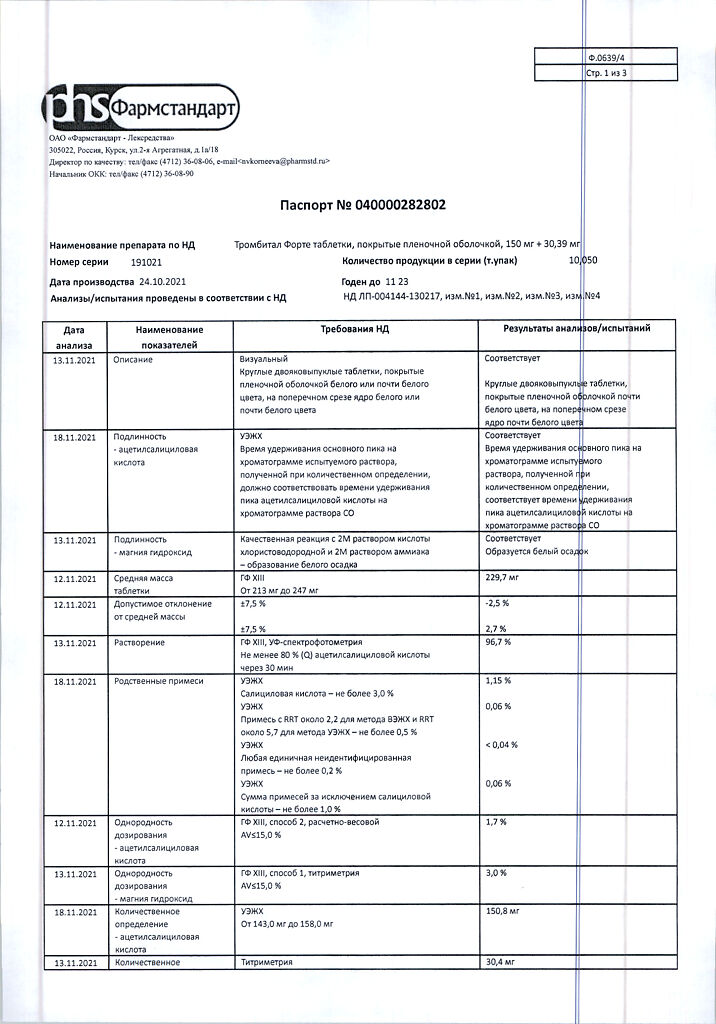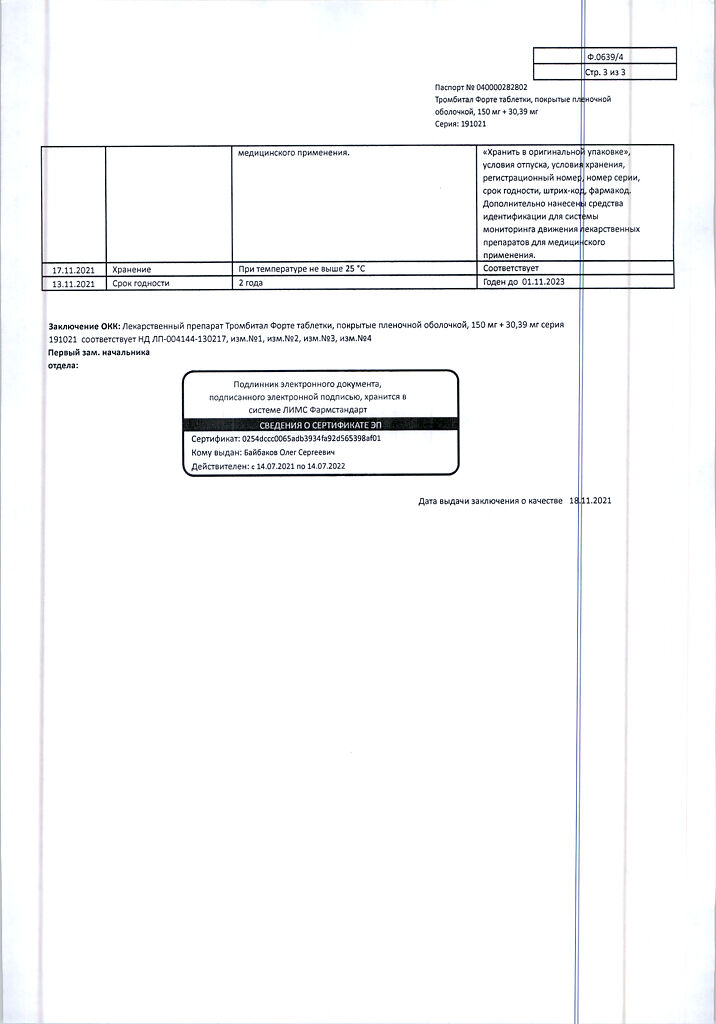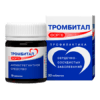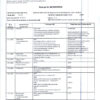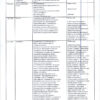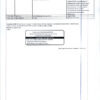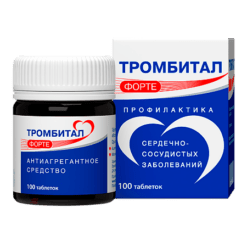No products in the cart.
Trombital Forte, 150 mg+30.39 mg 30 pcs
€1.00
Out of stock
(E-mail when Stock is available)
Description
Creases aggregation, platelet adhesion and thrombosis by inhibiting the synthesis of thromboxane A2 in platelets. Antiplatelet effect lasts for 7 days after a single dose (more pronounced in men than in women).
Acetylsalicylic acid reduces lethality and risk of myocardial infarction in unstable angina, it is effective in primary prevention of cardiovascular diseases, especially in men over 40 years old and in secondary prevention of myocardial infarction.
Suppresses prothrombin synthesis in the liver and increases prothrombin time. Increases the fibrinolytic activity of the blood plasma and reduces the concentration of vitamin K-dependent clotting factors (II, VII, IX, X). Increases the risk of hemorrhagic complications during surgical interventions, increases the risk of bleeding during anticoagulant therapy.
Acetylsalicylic acid in high doses also has anti-inflammatory, analgesic and antipyretic effects.
In high doses, acetylsalicylic acid stimulates excretion of uric acid (disrupts its reabsorption in the renal tubules).
Blockade of cyclooxygenase-1 in gastric mucosa leads to inhibition of gastroprotective prostaglandins, which may cause mucosal ulceration and subsequent bleeding.
Magnesium hydroxide, which is part of the drug Trombital Forte, protects the gastrointestinal mucosa from the effects of acetylsalicylic acid.
Indications
Indications
Primary prevention of cardiovascular diseases such as thrombosis and acute heart failure in the presence of risk factors (for example, diabetes mellitus, hyperlipidemia, hypertension, obesity, smoking, old age).
Prevention of cardiovascular diseases: recurrent myocardial infarction, blood vessel thrombosis.
Prevention of thromboembolism after vascular surgery (for example, coronary artery bypass grafting, percutaneous transluminal coronary angioplasty, etc.).
Unstable angina (including suspicion of acute myocardial infarction).
Pharmacological effect
Pharmacological effect
Reduces platelet aggregation, adhesion and thrombus formation by suppressing the synthesis of thromboxane A2 in platelets. The antiplatelet effect persists for 7 days after a single dose (more pronounced in men than in women).
Acetylsalicylic acid reduces mortality and the risk of myocardial infarction in unstable angina, is effective in the primary prevention of diseases of the cardiovascular system, especially myocardial infarction in men over 40 years of age, and in the secondary prevention of myocardial infarction.
Suppresses the synthesis of prothrombin in the liver and increases prothrombin time. Increases the fibrinolytic activity of blood plasma and reduces the concentration of vitamin K-dependent coagulation factors (II, VII, IX, X). Increases the risk of hemorrhagic complications during surgical interventions, increases the risk of bleeding during anticoagulant therapy.
Acetylsalicylic acid in high doses also has an anti-inflammatory, analgesic, and antipyretic effect.
In high doses, acetylsalicylic acid stimulates the excretion of uric acid (impairs its reabsorption in the renal tubules).
Blockade of cyclooxygenase-1 in the gastric mucosa leads to inhibition of gastroprotective prostaglandins, which can cause ulceration of the mucous membrane and subsequent bleeding.
Magnesium hydroxide, which is part of the drug Trombital Forte, protects the mucous membrane of the gastrointestinal tract from the effects of acetylsalicylic acid.
Special instructions
Special instructions
The drug should be used as prescribed by a doctor.
Tablets of the drug Trombital Forte are film-coated, do not have marks and are not intended for division, therefore, if the doctor recommends reducing the daily dose of acetylsalicylic acid to 75 mg, then switching to another drug containing 75 mg of acetylsalicylic acid in 1 tablet is required.
Acetylsalicylic acid can provoke bronchospasm, as well as cause attacks of bronchial asthma and other hypersensitivity reactions.
Risk factors include a history of bronchial asthma, hay fever, nasal polyposis, chronic respiratory diseases, and allergic reactions to other drugs (for example, skin reactions, itching, urticaria).
Acetylsalicylic acid can cause bleeding of varying severity during and after surgery. Several days before planned surgery, the risk of bleeding should be assessed in comparison with the risk of ischemic complications in patients taking low doses of acetylsalicylic acid.
If the risk of bleeding is significant, acetylsalicylic acid should be temporarily discontinued. The combination of acetylsalicylic acid with anticoagulants, thrombolytics and antiplatelet drugs is accompanied by an increased risk of bleeding.
Acetylsalicylic acid in low doses can provoke the development of gout in predisposed patients (those with reduced excretion of uric acid). The combination of acetylsalicylic acid with methotrexate is accompanied by an increased incidence of side effects from the hematopoietic organs.
High doses of acetylsalicylic acid have a hypoglycemic effect, which must be kept in mind when prescribing it to patients with diabetes mellitus receiving oral hypoglycemic agents and insulin.
When using systemic glucocorticosteroids and salicylates in combination, it should be remembered that during treatment the concentration of salicylates in the blood is reduced, and after discontinuation of systemic glucocorticosteroids, an overdose of salicylates is possible.
The combination of acetylsalicylic acid with ibuprofen is not recommended in patients with an increased risk of cardiovascular diseases: when used simultaneously with ibuprofen, a decrease in the antiplatelet effect of acetylsalicylic acid in doses of up to 300 mg is observed, which leads to a decrease in the cardioprotective effects of acetylsalicylic acid.
Increasing the dose of acetylsalicylic acid above therapeutic doses is associated with the risk of gastrointestinal bleeding.
With long-term use of low doses of acetylsalicylic acid as antiplatelet therapy, caution must be exercised in elderly patients due to the risk of gastrointestinal bleeding.
When taking acetylsalicylic acid with alcohol at the same time, there is an increased risk of damage to the mucous membrane of the gastrointestinal tract and prolongation of bleeding time.
With long-term use of the drug, you should periodically do a general blood test and a stool test for occult blood.
Impact on the ability to drive vehicles. Wed and fur.:
During treatment with acetylsalicylic acid, care must be taken when driving vehicles and engaging in potentially hazardous activities that require increased concentration and speed of psychomotor reactions.
Active ingredient
Active ingredient
Acetylsalicylic acid, [Magnesium hydroxide]
Active components
Active components
acetylsalicylic acid, magnesium hydroxide
Composition
Composition
Active ingredients:
acetylsalicylic acid – 150.00 mg, magnesium
hydroxide – 30.39 mg.
Excipients:
microcrystalline cellulose – 24.15 mg,
corn starch – 19.00 mg,
potato starch – 4.00 mg,
magnesium stearate – 0.30 mg.
Shell:
hypromellose (hydroxypropyl methylcellulose 15 cP) – 1.20 mg,
macrogol (polyglycol 4000) – 0.24 mg,
talc – 0.72 mg.
Pregnancy
Pregnancy
The drug is contraindicated during pregnancy (I and III trimesters); lactation period;
Contraindications
Contraindications
Hypersensitivity to acetylsalicylic acid, excipients of the drug and other non-steroidal anti-inflammatory drugs (NSAIDs);
bleeding in the brain;
tendency to bleeding (vitamin K deficiency, thrombocytopenia, hemorrhagic diathesis);
erosive and ulcerative lesions of the gastrointestinal tract (in the acute phase);
gastrointestinal bleeding;
bronchial asthma induced by taking salicylates and other NSAIDs;
a combination of bronchial asthma, recurrent polyposis of the nose and paranasal sinuses with intolerance to acetylsalicylic acid;
simultaneous use of methotrexate at a dose of 15 mg per week or more;
pregnancy (I and III trimesters);
lactation period;
deficiency of glucose-6-phosphate dehydrogenase;
severe renal failure (creatinine clearance (CC) less than 30 ml/min);
severe liver failure (class B and C on the Child-Pugh scale);
chronic heart failure of functional class III and IV according to the NYHA classification;
children under 18 years of age.
Side Effects
Side Effects
The adverse events listed below are distributed according to the frequency of occurrence in accordance with the following gradation: very often (with a frequency of more than 1/10), often (with a frequency of at least 1/100, but less than 1/10), infrequently (with a frequency of at least 1/1000, but less than 1/100), rarely (with a frequency of at least 1/10000, but less than 1/1000), very rare (with a frequency of less than 1/10000), including individual messages.
From the blood and lymphatic system: very often – increased bleeding (hematomas, nosebleeds, bleeding gums, bleeding from the genitourinary tract); rarely – anemia; very rarely – hypoprothrombinemia, thrombocytopenia, neutropenia, aplastic anemia, eosinophilia, agranulocytosis; unknown frequency – leukopenia.
There have been reports of serious cases of bleeding, which include gastrointestinal bleeding and cerebral hemorrhage (especially in patients with arterial hypertension who have not achieved target blood pressure values and/or receiving concomitant therapy with anticoagulant drugs), which in some cases can be life-threatening.
Bleeding can lead to the development of acute or chronic posthemorrhagic/iron deficiency anemia (for example, due to hidden bleeding) with corresponding clinical and laboratory signs and symptoms (asthenia, pallor, hypoperfusion). There are reports of cases of hemolysis and hemolytic anemia in patients with severe forms of glucose-6-phosphate dehydrogenase deficiency.
Allergic reactions: often – urticaria, Quincke’s edema; uncommon – anaphylactic reactions, including angioedema; unknown frequency – skin rash, itching, rhinitis, swelling of the nasal mucosa, cardiorespiratory distress syndrome, as well as severe reactions, including anaphylactic shock.
From the nervous system: often – headache, insomnia; infrequently – dizziness, drowsiness; rarely – tinnitus, intracerebral hemorrhage; unknown frequency – hearing loss, which may be a sign of a drug overdose (see section “Overdose”).
From the respiratory system, chest and mediastinal organs: often – bronchospasm.
From the gastrointestinal tract: very often – heartburn; often – nausea, vomiting; infrequently – pain in the abdomen, ulcers of the mucous membrane of the stomach and duodenum, including perforation (rarely), gastrointestinal bleeding; rarely – increased activity of liver enzymes; very rarely – stomatitis, esophagitis, erosive lesions of the upper gastrointestinal tract, strictures, irritable bowel syndrome, colitis; unknown frequency – loss of appetite, diarrhea.
From the urinary system: unknown frequency – impaired renal function and acute renal failure.
If you experience side effects
effects indicated in the instructions, or they get worse, or you notice any
other side effects not listed in the instructions, please inform your doctor.
Interaction
Interaction
Interaction with other drugs
When used simultaneously, acetylsalicylic acid enhances the effect of the following drugs:
– methotrexate by reducing renal clearance and displacing it from protein binding; the combination of acetylsalicylic acid with methotrexate is accompanied by an increased incidence of side effects from the hematopoietic organs;
– narcotic analgesics, other NSAIDs;
– heparin and indirect anticoagulants due to disruption of platelet function and displacement of indirect anticoagulants from connection with blood plasma proteins;
– thrombolytic, antiplatelet and anticoagulant drugs (ticlopidine);
– digoxin due to a decrease in its renal excretion;
– hypoglycemic agents for oral administration (sulfonylurea derivatives) and insulin due to the hypoglycemic properties of acetylsalicylic acid itself in high doses and displacing sulfonylurea derivatives from connection with blood plasma proteins;
– valproic acid by displacing it from its connection with blood plasma proteins.
The simultaneous use of acetylsalicylic acid with ibuprofen leads to a decrease in the cardioprotective effects of acetylsalicylic acid.
The combination of acetylsalicylic acid with anticoagulants, thrombolytics and antiplatelet agents is accompanied by an increased risk of bleeding.
Concomitant use with acetylsalicylic acid increases the concentration of barbiturates and lithium salts in the blood plasma.
By enhancing the elimination of salicylates, systemic glucocorticosteroids weaken their effect.
Glucocorticosteroids, ethanol and ethanol-containing drugs increase the negative effect on the mucous membrane of the gastrointestinal tract and increase the risk of developing gastrointestinal bleeding.
When acetylsalicylic acid is taken simultaneously with ethanol, an increase in the toxic effect of ethanol on the central nervous system is observed.
Acetylsalicylic acid weakens the effect of uricosuric drugs – benzbromarone, probenecid (reduced uricosuric effect due to competitive suppression of renal tubular excretion of uric acid), angiotensin-converting enzyme inhibitors (a dose-dependent decrease in glomerular filtration rate (GFR) is noted as a result of inhibition of prostaglandins with a vasodilating effect, and, accordingly, a weakening of the antihypertensive effect; a clinically significant decrease in GFR is observed with a daily dose of acetylsalicylic acid of more than 160 mg), diuretics (when combined with acetylsalicylic acid in high doses, a decrease in glomerular filtration rate is observed as a result of a decrease in the synthesis of prostaglandins in the kidneys).
Antacids and cholestyramine reduce the absorption of acetylsalicylic acid.
If you are using the above or other medications (including over-the-counter medications), consult your doctor before using Trombital Forte.
Overdose
It may occur after a single dose of a large dose or with long-term use of the drug. If a single dose of acetylsalicylic acid is less than 150 mg/kg, acute poisoning is considered mild, 150-300 mg/kg – moderate, and when using higher doses – severe.
Mild to moderate overdose symptoms:
dizziness, tinnitus, hearing loss, blurred vision, increased sweating, nausea, vomiting, headache, confusion, tachypnea, hyperventilation, respiratory alkalosis.
Treatment: provocation of vomiting, repeated intake of activated carbon, forced alkaline diuresis, restoration of water-electrolyte balance and acid-base state.
Symptoms of moderate to severe overdose:
• respiratory alkalosis with compensatory metabolic acidosis;
• hyperpyrexia (extremely high body temperature);
• respiratory disorders: hyperventilation, non-cardiogenic pulmonary edema, respiratory depression, asphyxia;
• disorders of the cardiovascular system: heart rhythm disturbances, decreased blood pressure, cardiac depression, collapse;
• disturbances of water and electrolyte balance: dehydration, impaired renal function from oliguria up to the development of renal failure, characterized by hypokalemia, hypernatremia, hyponatremia;
• impaired glucose metabolism: hyperglycemia, hypoglycemia (especially in children), ketoacidosis;
• tinnitus, deafness;
• gastrointestinal bleeding;
• hematological disorders: from inhibition of platelet aggregation to coagulopathy, prolongation of prothrombin time, hypoprothrombinemia;
• neurological disorders: toxic encephalopathy and depression of the central nervous system (drowsiness, confusion, coma, convulsions).
Treatment: immediate hospitalization in specialized departments for emergency treatment – gastric lavage, repeated intake of activated charcoal and laxatives, alkalization of urine (indicated when the level of salicylates is above 500 mg/l, provided by intravenous infusion of sodium bicarbonate – 88 mEq in 1 liter of 5% glucose solution, at a rate of 10-15 ml/kg/h), restoration of circulating blood volume and induction of diuresis (achieved by administering sodium bicarbonate in the same dose and dilution, repeat 2-3 times); It should be borne in mind that intensive fluid infusion in elderly patients can lead to pulmonary edema. The use of acetozolamide for alkalinization of urine is not recommended (it can cause acidemia and enhance the toxic effect of salicylates). When carrying out alkaline diuresis, it is necessary to achieve pH values between 7.5 and 8. Hemodialysis is indicated when the level of salicylates in the blood plasma is more than 1000 mg/l, and in patients with chronic poisoning – 500 mg/l and below if indicated (refractory acidosis, progressive deterioration, severe damage to the central nervous system, pulmonary edema and renal failure). For pulmonary edema, artificial ventilation of the lungs with an oxygen-enriched mixture in positive end-expiratory pressure mode is indicated; hyperventilation and osmotic diuresis are used to treat cerebral edema.
The greatest risk of developing chronic intoxication is observed in elderly people when taking more than 100 mg/kg/day for several days. In children and elderly patients, the initial signs of salicylicism (nausea, vomiting, tinnitus, blurred vision, dizziness, headache, general malaise) are not always noticeable, so it is advisable to periodically determine the content of salicylates in the blood plasma.
Overdose
Overdose
It may occur after a single dose of a large dose or with long-term use of the drug. If a single dose of acetylsalicylic acid is less than 150 mg/kg, acute poisoning is considered mild, 150-300 mg/kg – moderate, and when using higher doses – severe.
Symptoms of mild to moderate overdose: dizziness, tinnitus, hearing loss, blurred vision, increased sweating, nausea, vomiting, headache, confusion, tachypnea, hyperventilation, respiratory alkalosis.
Treatment: provocation of vomiting, repeated intake of activated carbon, forced alkaline diuresis, restoration of water-electrolyte balance and acid-base state.
Symptoms of moderate to severe overdose:
respiratory alkalosis with compensatory metabolic acidosis;
hyperpyrexia (extremely high body temperature);
respiratory disorders: hyperventilation, non-cardiogenic pulmonary edema, respiratory depression, asphyxia;
disorders of the cardiovascular system: heart rhythm disturbances, decreased blood pressure, cardiac depression, collapse;
disturbances of water and electrolyte balance: dehydration, impaired renal function from oliguria up to the development of renal failure, characterized by hypokalemia, hypernatremia, hyponatremia;
impaired glucose metabolism: hyperglycemia, hypoglycemia (especially in children), ketoacidosis;
tinnitus, deafness;
gastrointestinal bleeding;
hematological disorders: from inhibition of platelet aggregation to coagulopathy, prolongation of prothrombin time, hypoprothrombinemia;
neurological disorders: toxic encephalopathy and depression of the central nervous system (drowsiness, confusion, coma, convulsions).
Treatment: immediate hospitalization in specialized departments for emergency treatment – gastric lavage, repeated intake of activated charcoal and laxatives, alkalization of urine (indicated when the level of salicylates is above 500 mg/l, provided by intravenous infusion of sodium bicarbonate – 88 mEq in 1 liter of 5% glucose solution, at a rate of 10-15 ml/kg/h), restoration of circulating blood volume and induction of diuresis (achieved by administering sodium bicarbonate in the same dose and dilution, repeat 2-3 times); It should be borne in mind that intensive fluid infusion in elderly patients can lead to pulmonary edema.
The use of acetozolamide for alkalinization of urine is not recommended (it can cause acidemia and enhance the toxic effect of salicylates). When performing alkaline diuresis, it is necessary to achieve pH values between 7.5 and 8.
Hemodialysis is indicated when the level of salicylates in the blood plasma is more than 1000 mg/l, and in patients with chronic poisoning – 500 mg/l and below if indicated (refractory acidosis, progressive deterioration, severe damage to the central nervous system, pulmonary edema and renal failure).
For pulmonary edema, artificial ventilation of the lungs with an oxygen-enriched mixture in positive end-expiratory pressure mode is indicated; Hyperventilation and osmotic diuresis are used to treat cerebral edema. The greatest risk of developing chronic intoxication is observed in elderly people when taking more than 100 mg/kg/day for several days.
In children and elderly patients, the initial signs of salicylicism (nausea, vomiting, tinnitus, blurred vision, dizziness, headache, general malaise) are not always noticeable, so it is advisable to periodically determine the content of salicylates in the blood plasma.
Short product description
Short product description
Trombital Forte® is a new “heart aspirin”* with magnesium hydroxide for people with risk factors or known diseases of the cardiovascular system**, which prevents the development of thrombosis – the main cause of heart attacks and strokes, without harm to the stomach*** and at an affordable price****.
Trombital®. For the heart at an affordable price!
The risk of developing small intestinal ulcers is 5-7 times lower when using a buffer form of ASA compared to enteric-soluble*****. Trombital is completely bioequivalent to the original drug******.
The main advantages of Trombital Forte®.
1. The gastrosoluble (buffer) form of ASA with magnesium has better absorption, recommended by WHO(1);
2. Effective doses of ASA (75-150 mg) demonstrate the maximum effect in reducing the risk of CVD(2);
3. Contains magnesium hydroxide, which helps protect the gastric mucosa from the locally irritating effect of acetylsalicylic acid;
4. Available analogue of the original drug;
5. Full bioequivalence to the original drug;
6. Just 1 tablet per day(3).
Advantages of the release form.
Convenient and accurate dosing – there is no need to divide the tablet in half. The small, round tablets are easy to swallow. Simple regimen – 1 tablet per day(3).
*”Cardiac aspirin” means low-dose ASA for daily preventive use. Vasiliev V.
**Keys to health, 2011. “Aspirin” is a generally accepted synonym for ASA – Shilov A.M. Russian medical journal. Medical Review. 2013. T. 21. No. 35. P. 1804-1808.
***Instructions for the medical use of the drugs Trombital and Trombital Forte. Vorobyova N.M. The influence of the dosage form of acetylsalicylic acid on the safety of long-term treatment. Consilium Medicum. 2014, volume 16, no. 10.
****The average retail price for Trombital Forte is affordable in the category of antiplatelet agents according to data from IQUVIA Solutions LLC 2018-2019, including in comparison with Cardiomagnyl drugs (30%).
*****Endo H, Sakai E, Takuma T et al. Differences in the severity of small bowel mucosal injury based on the type of aspirin as evaluated by capsule endoscopy. Digestive and Liver Disease 44 (2012) 833–838.
******Prospective open randomized crossover study No. MGK/B02-15 https://grls.rosminzdrav.ru/CIPermissionMini.aspx?CIStatementGUID=cdb4de7a-8686-44b0-987d-538df9224a… ;
Prospective open randomized crossover study No. MGK/B01-15 https://grls.rosminzdrav.ru/CIPermissionMini.aspx?CIStatementGUID=f2940949-76eb-4be2-9d15-d75601d97d….
(1)http://archives.who.int/eml/expcom/expcom16/COMMENTS/Report/ASA.pdf
(2)Collaborative meta-analysis of randomized trials of antiplatelet therapy for prevention of death, myocardial infarction, and stroke in high risk patients. BMJ 2002; 324: 71-86.
(3)Primary prevention of cardiovascular diseases
Round biconvex tablets, film-coated, white or almost white, with a cross-section of the core white or almost white.
Functional features
Functional features
Acetylsalicylic acid is absorbed from the gastrointestinal tract almost completely. The half-life of acetylsalicylic acid is about 15 minutes, because with the participation of enzymes, acetylsalicylic acid is quickly hydrolyzed into salicylic acid in the intestines, liver and blood plasma. The half-life of salicylic acid is about 3 hours, but it can increase significantly with the simultaneous administration of large doses of acetylsalicylic acid (more than 3.0 g) as a result of saturation of enzyme systems.
The bioavailability of acetylsalicylic acid is 70%, but this value fluctuates significantly, since acetylsalicylic acid undergoes presystemic hydrolysis (gastrointestinal mucosa, liver) into salicylic acid under the action of enzymes. The bioavailability of salicylic acid is 80-100%.
The doses of magnesium hydroxide used do not affect the bioavailability of acetylsalicylic acid.
Reduces platelet aggregation, adhesion and thrombus formation by suppressing the synthesis of thromboxane A2 in platelets. The antiplatelet effect persists for 7 days after a single dose (more pronounced in men than in women).
Acetylsalicylic acid reduces mortality and the risk of myocardial infarction in unstable angina, is effective in the primary prevention of diseases of the cardiovascular system, especially myocardial infarction in men over 40 years of age, and in the secondary prevention of myocardial infarction.
Suppresses the synthesis of prothrombin in the liver and increases prothrombin time. Increases the fibrinolytic activity of blood plasma and reduces the concentration of vitamin K-dependent coagulation factors (II, VII, IX, X). Increases the risk of hemorrhagic complications during surgical interventions, increases the risk of bleeding during anticoagulant therapy.
Acetylsalicylic acid in high doses also has anti-inflammatory, analgesic, and antipyretic effects.
In high doses, acetylsalicylic acid stimulates the excretion of uric acid (impairs its reabsorption in the renal tubules).
Blockade of cyclooxygenase-1 in the gastric mucosa leads to inhibition of gastroprotective prostaglandins, which can cause ulceration of the mucous membrane and subsequent bleeding.
Magnesium hydroxide, which is part of the drug Trombital Forte, protects the mucous membrane of the gastrointestinal tract from the effects of acetylsalicylic acid.
Storage conditions
Storage conditions
At a temperature not exceeding 25 °C.
Shelf life
Shelf life
2 years.
Manufacturer
Manufacturer
Pharmstandard-Leksredstva, Russia
Additional information
| Shelf life | 2 years. |
|---|---|
| Conditions of storage | At a temperature not higher than 25 ° C. |
| Manufacturer | Pharmstandard-Leksredstva, Russia |
| Medication form | pills |
| Brand | Pharmstandard-Leksredstva |
Other forms…
Related products
Buy Trombital Forte, 150 mg+30.39 mg 30 pcs with delivery to USA, UK, Europe and over 120 other countries.


